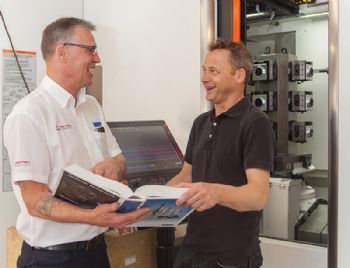
Having worked for Hertfordshire-based Precise Components since 1987, Ed Laanest jumped at the chance to buy the business when the owners retired in 2002. At the time, its roster of CNC machines comprised two basic models.
Precise Components has since expanded in terms of both floor space and machining capability. It now has a diverse mix of CNC lathes, mill-turn centres, vertical machining centres and — the latest arrival — a Mazak HCN 4000 four-axis horizontal machining centre with a six-pallet pallet pool. Many of these machines run 24/7.
Mr Laanest’s sons Tom and Sam now work full-time for Precise Components, and they are the ‘driving force’ in the development of the machining-centre side of the business, applying their expertise to the high-volume manufacture of architectural fittings, as well as high-precision parts for a variety of applications — including those for the lighting sector, where batch sizes can range from 500 to 10,000.
While much of this work is in aluminium, the company machines a wide range of materials — from plastics through to stainless steels.
Ed Laanest said: “The decision to invest in the Mazak was due, in part, to an order we received from our biggest customer for a large quantity of bespoke light fixtures.
“Our milling capability had fallen behind, with the VMCs loaded manually and needing an operator by them all the time. Installing the Mazak and its pallet system meant that we had a machining centre capable of running in ‘lights out’ mode.”
With this machine, which has an 18,000rev/min spindle and a 60-tool carousel (plus six pallets), Precise Components needed an effective work-holding solution and sought the help of Sheffield-based WNT (UK) Ltd (
www.wnt.com).
Tom Laanest said: “We had already used WNT’s ZSG4 vice system on our VMCs and were very happy with it; the versatility of the reversible jaws and the use of the zero-point location system makes them quick and easy use — and set up.
It therefore made perfect sense to equip the Mazak with the same work-holding system, while using tombstone clamping towers to get multiple vices on a single pallet. We subsequently bought six such towers and 72 ZSG4 vices.”
Minimal movement
A feature of these vices that appealed to Precise Components was the fact that the clamping process requires a maximum movement of just 160deg; and by using a torque wrench, the clamping power can be set precisely — up to the maximum 32kN.
Moreover, needing less than half a turn makes loading multiple vices (in what may be confined spaces) fast and precise, while the modular nature of the zero-point system allows different clamping set-ups to be retained for
future use. Another benefit is derived from the ZSG4’s jaws, which can grip on as little as 3mm of material.
In addition to work-holding solutions, Precise Components relies on tooling and machining advice from WNT’s local technical sales engineer Duncan Slough.
In fact, the new Mazak has been fully equipped with WNT tooling, including Centro P collets, for high-speed milling.

These are used in conjunction with WNTs diamond-like-coated (DLC) solid-carbide end mills for machining aluminium parts; moreover, these 16mm-diameter cutters are running at considerably higher speeds than conventional coated cutters could achieve — typical speeds in the order of 14,000rev/min and feeds of 10,000mm/min, along with a depth of cut of 48mm.
Tom Laanest said: “Using the Centro P collets in conjunction with the WNT DLC cutters, we are achieving tool life increases of 500% while halving cycle times.
“Moreover, the support we have had from Mr Slough has helped us adapt to the new equipment quickly. Since having the machine, we have also maximised our use of through-tool coolant — and used thread-forming for the first time.”
When installing the Mazak HCN 4000, Precise Components also invested in new CAM software, for which WNT provided CAD models of the company’s entire library of tools — plus models of its vices and tombstone fixtures.
Having this information readily to hand reduces any risk of collision when the programs are transferred to the machine.
Mr Slough concluded: “By working with our customers, who tend to be small and medium-size businesses, we can help them grow — and that is to the benefit of them and us.”